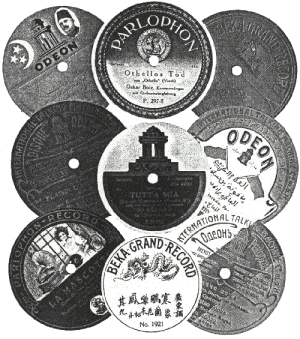
If ever a record company was shrouded in mystery, romance, misinformation and half-truths it was Odeon. It remains, perhaps, the single most important un-researched record label. Opera collectors have long admired the many vocal gems that Odeon issued, and to them we owe a debt of gratitude for some of the basic facts about the company's activities. What concerns us here, however, is the energy and time Odeon devoted to 'ethnic' markets.
The early history of the gramophone is as much one of litigation and boardroom machination as anything else. A golden age for lawyers, the specific history is best read in Welch's From Tinfoil to Stereo or Gellat's The Fabulous Phonograph.![]() 1 Odeon emerged from this free-for-all on 1 February 1904 as the registered trademark of the International Talking Machine GmbH, 24 Lehderstrasse, Berlin. Essentially, like all early companies, it existed to sell talking machines into the domestic market. For most early companies, the manufacture of records themselves was not the first consideration, but it was found necessary in order to maximise the sale of machines.
1 Odeon emerged from this free-for-all on 1 February 1904 as the registered trademark of the International Talking Machine GmbH, 24 Lehderstrasse, Berlin. Essentially, like all early companies, it existed to sell talking machines into the domestic market. For most early companies, the manufacture of records themselves was not the first consideration, but it was found necessary in order to maximise the sale of machines.
Carl Lindstroem, often thought of as the prime mover behind Odeon records was, in fact, more a figurehead than an active record man. His main genius lay in the scientific improvement of the talking machines themselves. He was a significantly talented inventor, but involved himself only minimally in record production. The actual founders of Odeon were Max Strauss and Heinrich Zunz. Partially backed by money from F. M. Prescott, recently resigned head of Zonophone, they bought out Lindstroem's small manufacturing workshop when Lindstroem found himself financially handicapped. Strauss, in a letter to a Dr. Veder in 1954, described Lindstroem as 'unmusical and hard of .![]() 2 Cynics may feel this comment was a fitting motif for an embryonic record industry.
2 Cynics may feel this comment was a fitting motif for an embryonic record industry.
For the next 30 years Strauss remained managing director of Odeon, and it was therefore he who was ultimately responsible for the company's early involvement in ethnic recording. Let us, however, attempt to see his activities in their true perspective. Like all early gramophone moguls, Strauss was no altruistic anthropologist. Nor, probably, did he regard his activities as historically important. Strauss was locked in a bitter struggle for world market domination with the London-based Gramophone Company and its European associates, with French Pathé with American Victor and Columbia and with a host of smaller fry who at that time represented a potential threat.
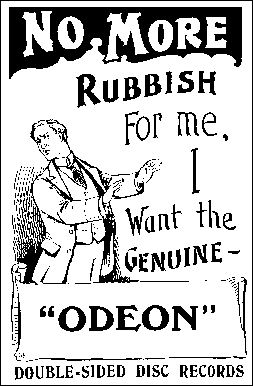 During the first year of business, Strauss sent the recording engineer John Daniel Smoot on a tour of North Africa, Greece and Turkey, in an attempt to capture those markets before the Gramophone Company could. Smoot almost certainly beat Gramco's Arthur Clarke to Smyrna by over a year, but surviving evidence is so scarce that it is almost impossible to evaluate the quality of Smoot's records. However, by 1905, Odeon claimed to have over 7,000 titles in Arabic, Greek and Turkish in catalogue. A year later this claim rose to 11,000 and had widened to include matrices taken by Smoot on a 1906 tour of the Orient.
During the first year of business, Strauss sent the recording engineer John Daniel Smoot on a tour of North Africa, Greece and Turkey, in an attempt to capture those markets before the Gramophone Company could. Smoot almost certainly beat Gramco's Arthur Clarke to Smyrna by over a year, but surviving evidence is so scarce that it is almost impossible to evaluate the quality of Smoot's records. However, by 1905, Odeon claimed to have over 7,000 titles in Arabic, Greek and Turkish in catalogue. A year later this claim rose to 11,000 and had widened to include matrices taken by Smoot on a 1906 tour of the Orient.
Odeon's early success was attributable to two main factors: first, they were aggressive worldwide marketers, with operational bases throughout Europe, South America and the Far East; and second, they had launched, early in 1904, the first double-sided records. Until Odeon's technical innovation, all flat discs were single-sided plates. Now, suddenly, the public was being offered a two-for-the-price-of-one deal, which Odeon covered with copious patenting. This activity caused deep concern at Gramco. On 4 April 1904, the Brussels office of Gramco wrote to the London based parent company:
I must draw your attention to the fact that these new (Odeon) records are doing us a lot of harm. Our travellers meet them everywhere and our agents do not stick to their contracts to sell only Gramo and Zono. They say the public insists on having these double records because they are only half the price of ours and much larger in proportion.3 If we do not want to lose our trade, something must be done to cut the Odeon out. To my opinion the most practical would be to reduce the Zonophone records to HALF the price of the Odeon records and then we will certainly soon recover our lost trade.
4
In the years prior to the 1914-1918 War, Odeon concentrated on consolidating its international position. The way in which it did this was simple, effective and ingenious. Instead of setting up an overseas branch, run by Odeon employees - a practice that Gramco largely favoured at that time - it appointed local agents whose task it was to find and negotiate terms with artists, arrange the recording programme and then request an engineer's visit to actually make the records. Once this had been done, the engineer would ship the masters back to Berlin for processing and manufacture. The finished product would then be 're-exported' to the agent ready to sell. By the 1920s both Gramco and Columbia had copied this practice, but Odeon's early employment of the technique gave them an edge on competitors, because local agents were often better able to understand the real needs of their own markets.
To illustrate this point, we can look at operations in Cairo. These started around late 1904, only a few months after the company had been formed. The appointed agents were H. & J. Blumenthal, who signed contracts with Ahmad Hasanaya and Yusif Rashidi, both traditional singers of some stature and importance. In 1906 the more prestigious actor-singer Salam Higazi, then 58 years old, was added to the roster. Higazi is widely accepted to be the father of Egyptian stage music, a style which strongly influenced Egyptian film music after 1931 and is therefore of significant cultural importance. To Odeon, what mattered was that he was popular and sold well. Until the outbreak of the First World War, Odeon's position in Egypt was pre-eminent, despite competition from Gramco and the locally owned Baidophon.
While these activities were going on, Odeon also moved into the buoyant Indian market. In 1904 they appointed Misquith & Co., a chain of department stores, as agents for machines and imported European recordings. By 1906, however, the dealership had moved to F.H. Christensen, an expatriate family of Swedish and Welsh origin, who were originally undertakers. By the middle of 1906 the Christensen family had established the Talking Machine Company of India at 51 Bentinck Street, Calcutta, and were preparing to enter into competition with, among others, Gramco, Nicolle Frères and Beka.
Odeon's first Indian recordings were made in late 1906 on a grand tour that took the engineers from Calcutta to Benares, then on to Lucknow, Cawnpore, Delhi, Amritsar, Lahore, Bombay and finally back to Calcutta. In all, they recorded some 700 titles, which were duly shipped back to Berlin for processing and manufacture in what was now the established worldwide pattern. The Talking Machine Company of India then appointed a number of subcontractors: the Empire Trading Co. of Bombay were to act as wholesalers for western India; M. Tara & Co. of Madras became distributors for southern India and an agency was established for Ceylon (Sri Lanka), at Colombo. In this way, Odeon effectively covered the bulk of the Indian subcontinent with its product.
Because of the diversity of language and cultural taste, Odeon's engineers recorded a great deal of regional music for local consumption. More so than, say Gramco, who were reasonably firmly entrenched in Calcutta. In a time before film music swept regional variations away, Odeon's activities allow us today to hear music that would otherwise have been irretrievable.
Elsewhere in the world, the story was largely one of parallel activity. By 1910 Odeon had successfully penetrated markets throughout Asia, including mainland China, Singapore and what was then the Dutch East Indies. All the music recorded in these areas could legitimately be classified as genuine ethnic music - little 'Europeanised' repertoire appears in any of the surviving catalogues. In 1909, one of the earliest and most important travelling recoding engineers, Fred Gaisburg, wrote to his brother Will:
The business in Java for the Odeon Company has been wonderful for the last two years, they being the only company in the field. The Odeon Company, during the last two years, have made two recording trips to Java, and are now starting on a third.Mr. Stebb, the sole agent of the Odeon for the Dutch Indies, has already made many enemies due to loose business transactions. The Chinamen in the Straits are the keenest businessmen in the east, and they are enthusiastic on talking machines and records. One Chinaman who assisted us had a contract with the Odeon C[ompan]y for 50,000 records in one year, but the Odeon gave him sole monopoly for six months; also an announcement was spoken on every record, giving this man's name. The quality of the Odeon records, the standard, is not very high but sales have been enormous. For example one firm gave an order to the Odeon for 45,000 records for one town, (Semarang) alone.
It is too bad that this Java trip was not made two or three years ago, when we would have been in the field before the Odeon. Now we have to follow their lead, and the only way that we can supplant them is by better records and clean business methods.
5
Gaisburg's complaint could have just as easily been about activity on the Iberian Peninsula, where again Odeon's aggressive marketing was cutting into Gramco's business. In Spain they recorded the legendary Antonio Chacon, issuing his records in a sequentially numbered 68000 series, and much else besides. In Portugal they employed their little known Fidelio subsidiary label to launch a significant series of genuine fados as early as 1909.
Odeon also ignored the unwritten 'gentleman's agreement' that existed between Gramco and American Victor not to poach in each other's territory. This handshake deal, worked up between the two companies within the first few years of business, effectively cut the world in two. Victor covered the Americas, from Canada to the bottom of Chile, taking in the Caribbean along the way, as well as Japan, the Pacific islands and parts of China. Gramco, by agreeing not to touch these territories, would then be free to concentrate on Europe, Africa and India. There would be some general sharing of the Dutch East Indies, South East Asia and China. Odeon, apparently not invited to the carving table by Gramco and Victor, simply went out for unilateral world domination and thus found itself in competition with both.
While Gramco's agreement with Victor prevented it from entering the Latin American market, it did not stop Odeon. Max Glucksmann, an expatriate German, had been appointed as the importation agent in Argentina for machines and European records in about 1904. He was vibrantly successful, and soon involved himself in making local records. Because of the distances involved, and possibly because of Glucksmann's nationality, Odeon agreed to build a processing and pressing plant for him in Buenos Aires, throwing in a resident Berlin-trained engineer for good measure. Glucksmann set out to capture the tango market, a task he managed very successfully. By 1914 he had essentially gained overall control of the Argentine record industry, marginalising his only competitor, Victor, by the simple expedient of signing exclusive long-term contracts with the best musicians and, more cannily, the best song writers. Because Glucksmann also controlled the sheet-music and silent movie house business, he had a virtual monopoly on tango until the 1920s.
In Brazil, also, the Odeon agents were quickly capitalising on the public's enthusiasm for the talking machine. Early examples of fados, lundus, maxixe and sambas exist because Odeon recorded them. Other contemporary Brazilian companies simply could not match their output.![]() 6
6
In July 1911 there was a major shakeout of business affairs in the German record industry. In a series of complex internal manoeuvres, Carl Lindstroem AG (the talking machine manufacturer) acquired a controlling interest in the International Talking Machine GmbH (the record manufacturer); in essence, a financial move that meant one side of the company buying out the other. Prior to this deal, the International Talking Machine Co. had been steadily absorbing smaller German record labels such as Decapo, Favourit, Jumbo and Lyraphone. With the merger, they also acquired Beka and Parlophon. Now, most German-based gramophone activities were effectively controlled from one operational base, a move that considerably enriched their overseas operational potential and represented a very real threat to Gramco and Victor.
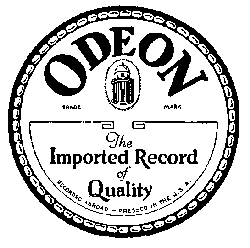 The outbreak of hostilities in Europe drove a deeper, nationalistic wedge between Gramco and Odeon. It did not, however, stop either company from pursuing expansionist policies. The most significant expansion that Odeon made during this period was to break into the American market. By setting up a deal with the General Phonograph Company, Odeon bought its way into North America and introduced not only the Odeon logo but also the first issues on what was to become a legendary American record label - OKeh.
The outbreak of hostilities in Europe drove a deeper, nationalistic wedge between Gramco and Odeon. It did not, however, stop either company from pursuing expansionist policies. The most significant expansion that Odeon made during this period was to break into the American market. By setting up a deal with the General Phonograph Company, Odeon bought its way into North America and introduced not only the Odeon logo but also the first issues on what was to become a legendary American record label - OKeh.
The contract between Otto Heinemann's General Phonograph and Carl Lindstroem A. G. was, in essence, a carbon-copy of the Victor / Gramco deal a decade previously. General Phonograph would control the American market, and use European matrices issued on Odeon for distribution within the USA (including Hawaii and Puerto Rico), Canada, Mexico and Cuba. Lindstroem would control the rest of the world - Europe, Asia, Africa, Australia, Central and South America 'and all territorial possessions belonging to or adjacent any of said territories' - and have access to American-made matrices for issue within its allotted territory. Extracts from this 1916 contract are enlightening:
The expression 'foreign language records' shall be deemed and construed to include the records made or to be made by Lindstroem, which records consist of religious prayers, declamation or songs in languages other than in English and rendered vocally as well as records of special national instruments, or special national bands characteristic of the following Eastern countries: Old Empire of Russia, China, India (including Dutch East Indies) Balkan States, and which at the time of signing of this agreement are not used in the United States and which records, as aforesaid, are sold in the regular cheap class repertoires.With this deal signed, Odeon now had a foothold in every gramophone market in the world. Despite the outcome of the 1914-1918 war, Odeon survived and prospered. It was now a well-established world class company with global trading activity firmly linked to the Berlin base. In 1919, Odeon moved to new and vast premises at Schlesiche Strasse, at the edge of Berlin's Kreuzberg district on the River Spree. Originally the building had been a brass works, built in the 19th century by tycoon Julius Heckmann. Odeon enlarged and modernised the building, installing offices and recording studios. They constructed vast new pressing plants, workshops and warehouses around it and essentially consolidated all their resources into one huge area. Strategically it was perfect, for it was surrounded by the Spree and had the advantage of two shipping channels running straight into the factory and warehouse area. Thus it was possible to load export goods directly onto cargo vessels for world wide distribution.The expression "foreign language records" shall not include instrumental recordings of any kind whatsoever, except as specifically otherwise stated in this paragraph.
7
From 1920 to 1926 Odeon continued to expand its operations. It also continued to be a thorn in the side of the other majors, and provided stiff worldwide competition. However, big changes were looming and the first rumblings occurred in late 1925 when Western Electric launched its electrical recording system. Up to this point, all recording activity had been acoustic. Engineers had tried, largely unsuccessfully, to improve upon the original sound quality by introducing multi-horn recording and quieter surfaces on the finished product, but recorded sound was still the product of an entirely mechanical process. Now, with the introduction of the moving coil microphone, the record industry faced a huge new challenge and the next big corporate shakeout was about to occur.
In order to understand what happened, it is necessary to sketch in some background. When Western Electric perfected the moving coil system they offered it to American Columbia first. Louis M. Stirling, the American-born head of English Columbia moved swiftly and bought out American Columbia in order to secure the rights to electrical recording. A few months later, he also bought American OKeh-Odeon. Talking Machine World for 15 October 1926 carried the details (see illustration).
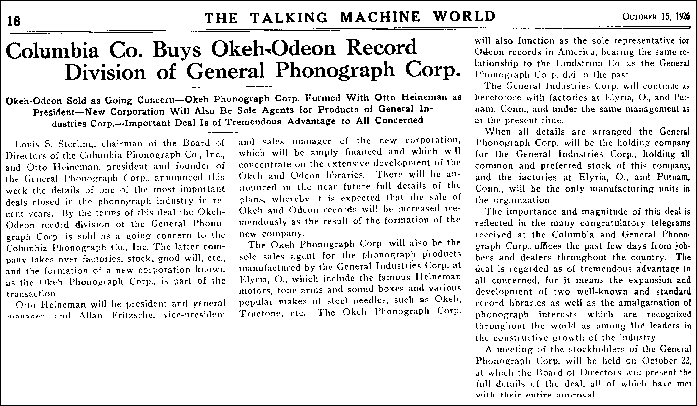
In the meantime, foreign recording activity continued unabated. Much of Odeon's own archives were destroyed during 1945, and thus surviving evidence of their activities often comes from reports compiled by other companies. The following examples, culled from internal reports made by executives at Gramco and Columbia, not only highlight the extent and nature of Odeon's activities but also illustrate the mood they created in their competitors. Following a trip to Greece, Turkey and the Middle East in Spring 1926, a Mr Sheard of Gramco noted:
Odeon have no satisfactory representative in Baghdad but they are anxious to obtain a footing and have a Mr. Guttmann going to Baghdad during April when a recording is expected to take place. As our best artists have been bound over here for 12 months he is expected to find it difficult to obtain good results.Mr Greenburg has been for many years in Constantinople and thoroughly understands the trade. Some years ago he undertook management of a recording session for Odeon, in fact, he introduced the records in Turkey.
Columbia, Vox Polydor and Odeon are all on sale here [Greece]. The Odeon Co. concluded a recording session in Athens about three months ago. The records are not very good but are selling as novelties.
[Egypt:] Odeon made their last Arabic recording in 1924 when they secured the famous female singer Om Kolsoum. This artist alone cost them £1000 but unfortunately the records were not satisfactory to the artist so Mr. Vogel has been unable to secure her. For the session we are holding in Cairo in May this year, she will make 10 double sided records for about £500.
Whilst the records referred to above are open to criticism, they certainly had the effect of reviving the interest of the Arabs in Odeon. The agents of the Odeon are 'Les Fils Lieto Barouk', Cairo and in addition to the records they also sell German machines, including some with glass panels; which are liked by the natives.
8
An unsigned report from Athens to Gramco in 1929 observed that:
Odeon have followed our example, but with more persistency. Thanks to their agents, since 1922 they record regularly and every time with great success. They have the best lists of Greek records. Their arrangements for keeping abreast of hits are very complete. In addition to recording twice a year in Athens (in February and September) they record in Berlin when required, all western 'hits' and extracts from Greek Operettas and musical comedies.In May 1930 a letter to Hayes from Gramco's Portuguese agent, Grand Bazaar do Porto, reported that:
This company (Odeon) has an exclusive agent for Portugal, Ricardo Lemos, who gives three of his best dealers the liberty of organising recording sessions whenever they want, and which they pay for themselves. Therefore, as there are four persons that may record in Portugal for this company, they very often have sessions out here. Their Portuguese records are very well sold [sic].An internal Gramco report by H. E. Evans in May 1931 commented extensively on Odeon's activities in East Africa:
A Swahili recording session took place in Mombassa at the beginning of 1930 at which 215 records in all were recorded. The artists are mainly the same as those who have recorded for us. The prices paid to singers ranged from 20/- to 15/-. The artist Sitti Binti from Zanzibar was paid 20/- per title plus travelling expenses from Zanzibar and 4/- per day expenses for food. These expenses are stated to have been borne by Hansing & Co. , who also paid the recording expert 50/-, being his fee per record. Ten records are being issued monthly and up to the present 108 have been issued.In 1931 everything changed again with the formation of Electrical Music Industries (EMI). The global merger brought the Columbia, Electrola, HMV, Odeon, Path‚ and Parlophone labels, together with smaller logos, under one umbrella operation based at Hayes in Middlesex. It was a bold move, designed to eliminate competition in a shrinking depression-ridden market. Ultimately, it worked, but the process took a while to sink in around the world. Agents who, for years, had been fiercely loyal to one label found it difficult to cope with the changes. Ricardo Lemos, Odeon's original Portuguese agent and the firm which had first conducted Odeon recording in that country, was still offering better discounts on Odeon products to his customers as late as 1934. He simply could not grasp that a merger had occurred. In some cases the companies themselves had problems shedding their old practices; indeed, a few employees seemed unsure of just who was involved in the merger. In June 1931, when the merger was only a few weeks old, the following internal memo passed from a Mr Cooper to a Mr Brown at Hayes:UGANDA: A recording session was held in Kampala immediately after the Mombasa session. The arrangements were in the hands of the Uganda Bookshop who hold the dealership for the territory.
The expenditure was borne by the latter concern; about 60 titles were recorded and the artists were paid 15/- to 20/- per title. One issue of 23 records has so far been made of which 11 were purely native music and the remaining 12 were church music sung in Swahili. The former obtained a large sale with the result that the first supply was soon sold out. Many registered orders have been booked. The church music has not sold at all. The Uganda Bookshop are stated to be under contract to take 500 copies of each recording issued. It is proposed to issue the remaining records over a period of two years. The Uganda Bookshop, who are stated to have over 20 branches throughout Uganda have thus been able to get the records all over the territory. As there is no electricity in Uganda, the current for recording was supplied by means of batteries.
PORTUGUESE EAST AFRICA: Odeon are the only company who have recorded in this territory. Their recorder visited Lourenço Marques and Beira last year and sessions were held in both towns at which records were made of all the principal languages. In Lourenço Marques large stocks were received and dealers state that the demand has been enormous. The cost of the recording is stated to have been small as the artistes were only paid a nominal sum and the average per title was 10/-. The expenses in this connection were borne by D. Spanos in accordance with the Odeon Company's policy in other territories.
It has been reported to me that one of our most important Hindustani artistes, Miss Dulari, has recently been approached by Odeon with an offer of Rs.10,000 for 40 titles.There were also some problems reconciling the pressing quantities that each individual company had previously accepted as minimum:As negotiations are proceeding at the present time with this artiste, who has been wholly exclusive to us, I shall be glad to know whether the Odeon Company is affiliated in any way with the Columbia Company. If any control exists, it would help us considerably if Odeon were advised to refrain from any interference with our artists in this territory.
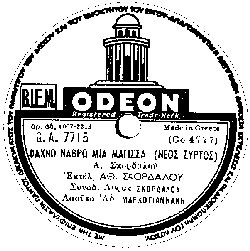
We have received a telegram from the Parlophone agents in Greece. These people protest that they should be forced to order immediately 300 records of each new recording. They maintain they would rather defer from giving any orders at all. I am told that they have made 136 records (83 combinations) and that they offer to give an order of 200 records on an average of all these combinations as the first order. I know that Mr Guesnon, for his recordings in French colonies has given initial orders of 100 and even 50 copies per combination, for example the records of Madagascar and Marocco. In my opinion it might prove the wrong policy to demand such big quantities for such small markets.Slowly, the merger message sank in with agents and distributors worldwide. It had an impact at the home bases also. Although it must have gone against some very old grain, given the secrecy with which business had been conducted prior to the merger, information was now starting to pass more freely between the new partners. On 12 October 1931 the following telegram was sent from Lindstroem's Berlin office to Hayes:9
We beg to give you below the names of three Burmese exclusive artists with whom we have made contracts:- information that, had it been exchanged twelve months earlier, would surely have got its author fired!
Liberty Ma Mya Yin
University Mya Than Kyi
Chin Ma Galay Aung Sein
As soon as we receive further information from our agents about the exclusive contracts with artists in British India, Ceylon and Dutch East Indies we shall let you have same.
Nine months later, however, Berlin was happily sending information on newly signed artists to Hayes. In October of that year they sent a list of a dozen new Indian artists signed by the agent in Bombay and Madras. Perhaps these local agents still didn't fully understand the ramifications of the merger, but the main offices were now exchanging information much more freely. In fact, they were prepared to blow the whistle on maverick agents who previously they would have supported:
We are getting from our Roumanian agent a letter dated 2nd December. As you will see from attached the whole trade seems to be alarmed owing to the fact that Mssrs. Galeries Lafayette are selling HMV records, the retail price of which is Lei 170, at a price of Lei 90.Newly vested interests clearly had to be protected.It stands to reason that this sale is bound to upset the whole market the more so, as the sale at that price does not only compromise an old unsaleable stock but newest hits. It seems to be unavoidable that difficulties will arise unless you will immediately take the necessary steps to stop this sale without any delay.
10
By 1933, all was going well. The merger had proved a success, eliminating previous competition between the various companies. Although there still was competition, principally from the brash new Decca Company and Polydor / Brunswick, EMI held the lion's share of record sales worldwide outside the USA. However, for Odeon, an unexpected turn of events was about to unfold.
When the Nazi party first took office in 1933 they were generally too busy dealing with more pressing matters to concern themselves with the record industry. In 1934, however, they thought about it and decided to 'Aryan-ise' German record catalogues. The first things to disappear were the great Cantorial recordings. Evidence is nowhere more startling than a comparison of a 1933 catalogue, which lists many records by Sirota, Kwartin and others, and a 1934 edition which does not. In 1936 the then director of Odeon, Mr. Guttmann, was forced to leave his position and was replaced by a Dr. Kepler, a Nazi party member who, according to Max Strauss, "was not burdened with any knowledge of the business".![]() 11 Because it ran contrary to the Aryanisation process, all Berlin-based overseas recording activities ceased in countries deemed by Kepler to be 'non-Aryan'.
11 Because it ran contrary to the Aryanisation process, all Berlin-based overseas recording activities ceased in countries deemed by Kepler to be 'non-Aryan'.
When hostilities erupted in 1939, Odeon (and Electrola) were considered to be 'enemy property' and placed under the trusteeship of a Nazi-appointed administrator. It did not stop Hayes from continuing to use the logo, as it did for a series of Argentine tango releases, but of course it cut off the German wing of EMI for the duration of the war. Sections of the Lindstroem factory were requisitioned for aircraft production. Such recording activity as there was, for domestic consumption, often took place in Prague or Brussels.
When the Russians entered Berlin in 1945 they destroyed large areas of the Odeon factory. Reports suggest that they threw all the office files, archive material, recording ledgers and card indices into the main courtyard and burned them. Metalwork and shellac file copies were apparently used for target practice and large areas of the complex were set on fire.
With the war over, Odeon again came back into the EMI fold. Its resources and infrastructures had been severely damaged and the old factory was now sitting in East Berlin, effectively cut off from rescue and reconstruction. Nevertheless, by the late 1940s Odeon was recording and pressing for the domestic market, but its days as a recognisable label were numbered. Within the EMI organisation, the name continued to be used on labels for pressings made for West Africa, but these were manufactured at Hayes. In Brazil the label survived as an EMI subsidiary until the mid 1960s when it finally disappeared completely.
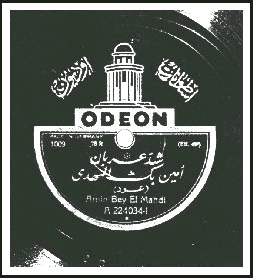 During the 61 years that the name Odeon appeared on record it brought a vast and diverse catalogue of music to a worldwide audience.
During the 61 years that the name Odeon appeared on record it brought a vast and diverse catalogue of music to a worldwide audience.
Surviving copies of classic Odeon ethnic recordings prove that the company's gambit of leaving A&R to local agents paid off, more often than not. One has only to hear, for example, Odeon's Portuguese, West African or Sardinian recordings to appreciate this.
Strauss, Zunze, Heinemann and, yes, deaf old Lindstroem, left a remarkable legacy behind them that deserves to rediscovered and appreciated. Without their efforts, the recorded heritage of early world music would be considerably thinner.
Paul Vernon - 31.7.97
Article MT003
With extreme thanks to: Bruce Bastin, British Library, Valentim de Carvalho, Keith Chandler, Ruth Edge & EMI Archives, Nigel Gallop, Michael Kinnear (for information on India), Dr. Rainer Lotz, Diane Mueller, National Sound Archive, not to mention Ronald Taylor and William Breslin, two charming old opera buffs who didn't give a monkey's about all that funny foreign stuff but nevertheless opened their archives to me.
All illustrations from author's archive, EMI, NSA and British Library.
| Top of page | Home Page | Articles | Reviews | News | Map |